brakes SUBARU BRZ 2023 Owners Manual
[x] Cancel search | Manufacturer: SUBARU, Model Year: 2023, Model line: BRZ, Model: SUBARU BRZ 2023Pages: 432, PDF Size: 16.56 MB
Page 146 of 432

Warning and Indicator Lights
140■ABS Warning LightThe ABS warning light illuminates
together with the brake system warning
light if the EBD system malfunctions. For
further details of the EBD system malfunc- tion warning, refe
r to "Brake System
Warning Light" P140.
NOTEIf the warning light behavior is as
described in the following conditions,
the ABS may be considered normal.
The warning light illuminates right
after the engine is started but turns off
immediately, remaining off.
The warning light remains illumi-
nated after the engine has been
started, but it turns off while driving.
The warning light illuminates during
driving, but it turns off immediately and
remains off.
When driving with an insufficient battery
voltage such as when the engine is jump
started, the ABS warn ing light may illumi-
nate. This is due to the low battery voltage
and does not indicate a malfunction.
When the battery becomes fully charged,
the light will turn off.
■ Brake System
Warning LightThis light has the following functions.
▼ Parking brake warning
The light illuminates with the parking
brake applied while the ignition switch is in
the “ACC” or “ON” position. It turns off
when the parking brake is fully released.
▼ Brake fluid level warningThis light illuminates when the brake fluid
level has dropped to near the “MIN” level
of the brake fluid reservoir with the ignition
switch in the “ON” position and with the
parking brake fully released.
CAUTION
If any of the following conditions
occur, we recommend that you
have the ABS (Anti-Lock Brake
System) repaired at the first avail-
able opportunity by your
SUBARU dealer.
- The warning light does not
illuminate when the ignition
switch is turned to the “ON”
position.- The warning light illuminates
when the ignition switch is
turned to the “ON” position,
but it does no t turn off even
after starting the vehicle.- The warning light illuminates
during driving.
When the warning light is on (and
brake system warning light is off),
the ABS function shuts down;
however, the conventional brake
system continues to operate
normally.
WARNING
Driving with the brake system
warning light on is dangerous.
This indicates your brake system
may not be working properly. If
the light remains illuminated,
have the brakes inspected by a
SUBARU dealer immediately. If at all in doubt about whether the
brakes are operating properly, do
not drive the vehicle. Have your
vehicle towed to the nearest
SUBARU dealer for repair.
BRZ_U.book 140 ページ 2022年3月29日 火曜日 午後3時59分
Page 241 of 432
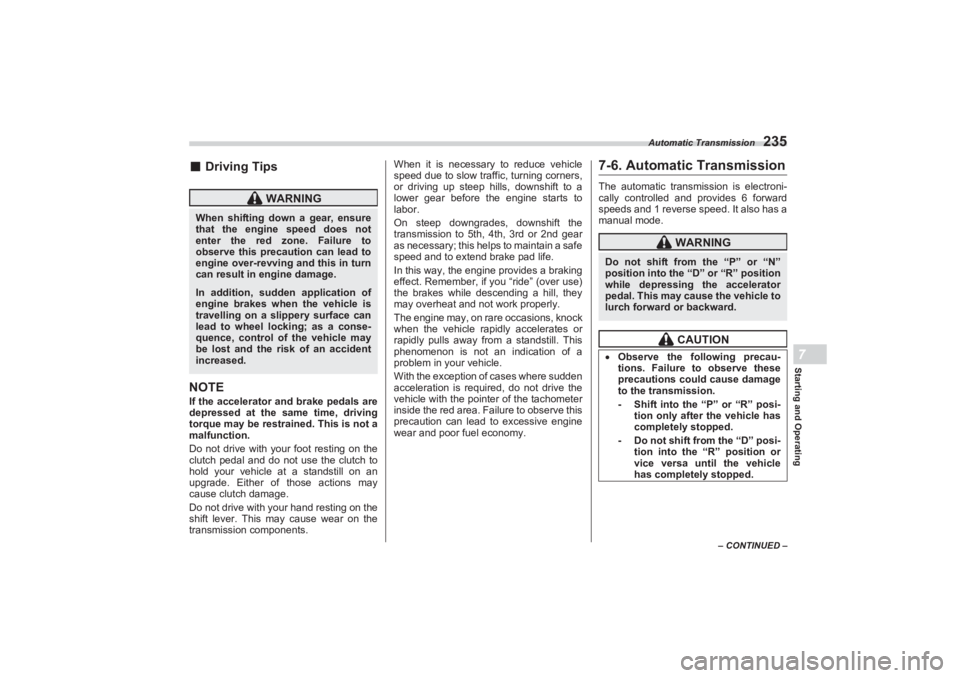
Automatic Transmission
235
Starting and Operating7
– CONTINUED –
■Driving TipsNOTEIf the accelerator and brake pedals are
depressed at the same time, driving
torque may be restrained. This is not a
malfunction.
Do not drive with your foot resting on the
clutch pedal and do not use the clutch to
hold your vehicle at a standstill on an
upgrade. Either of those actions may
cause clutch damage.
Do not drive with your hand resting on the
shift lever. This may cause wear on the
transmission components. When it is necessary to reduce vehicle
speed due to slow traffic, turning corners,
or driving up steep hills, downshift to a
lower gear before the engine starts to
labor.
On steep downgrades, downshift the
transmission to 5th, 4th, 3rd or 2nd gear
as necessary; this helps to maintain a safe
speed and to extend brake pad life.
In this way, the engine provides a braking
effect. Remember, if you “ride” (over use)
the brakes while descending a hill, they
may overheat and not work properly.
The engine may, on rare occasions, knock
when the vehicle rapidly accelerates or
rapidly pulls away from a standstill. This
phenomenon is not an indication of a
problem in your vehicle.
With the exception of cases where sudden
acceleration is required, do not drive the
vehicle with the pointer of the tachometer
inside the red area. Failure to observe this
precaution can lead to excessive engine
wear and poor fuel economy.
7-6. Automatic TransmissionThe automatic transmission is electroni-
cally controlled and provides 6 forward
speeds and 1 reverse speed. It also has a
manual mode.
WARNING
When shifting down a gear, ensure
that the engine speed does not
enter the red zone. Failure to
observe this precaution can lead to
engine over-revving and this in turn
can result in engine damage.In addition, sudden application of
engine brakes when the vehicle is
travelling on a slippery surface can
lead to wheel locking; as a conse-
quence, control of the vehicle may
be lost and the risk of an accident
increased.
WARNING
Do not shift from the “P” or “N”
position into the “D” or “R” position
while depressing the accelerator
pedal. This may cause the vehicle to
lurch forward or backward.
CAUTION
Observe the following precau-
tions. Failure to observe these
precautions could cause damage
to the transmission.
- Shift into the “P” or “R” posi- tion only after the vehicle has
completely stopped.- Do not shift from the “D” posi- tion into the “R” position or
vice versa until the vehicle
has completely stopped.
BRZ_U.book 235 ページ 2022年3月29日 火曜日 午後3時59分
Page 249 of 432
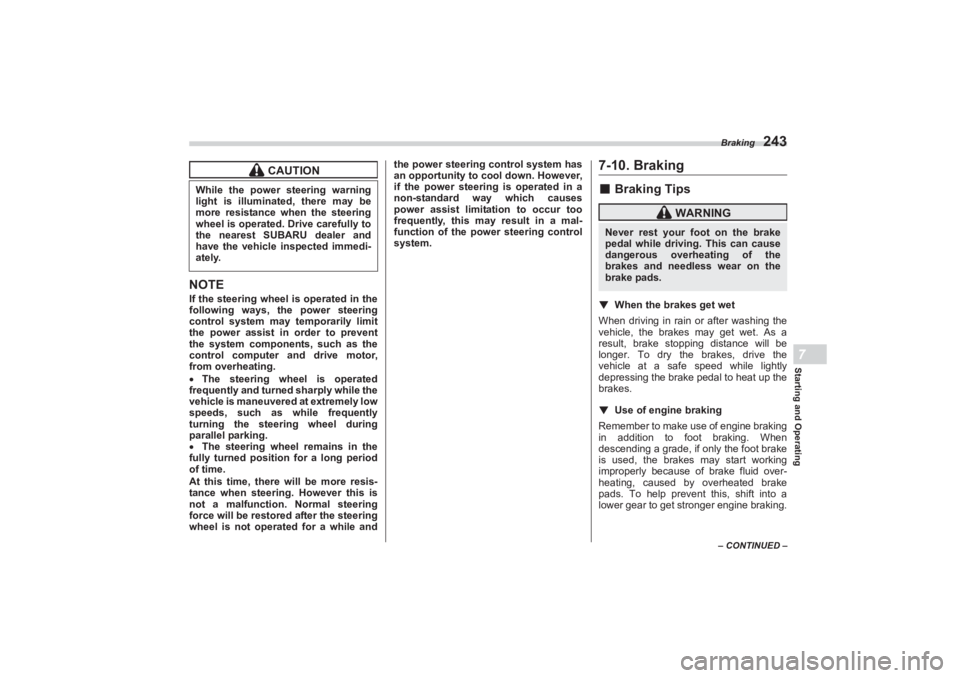
Braking
243
Starting and Operating7
– CONTINUED –
NOTEIf the steering wheel is operated in the
following ways, the power steering
control system may temporarily limit
the power assist in order to prevent
the system components, such as the
control computer and drive motor,
from overheating.
The steering wheel is operated
frequently and turned sharply while the
vehicle is maneuvered at extremely low
speeds, such as while frequently
turning the steering wheel during
parallel parking.
The steering wheel remains in the
fully turned position for a long period
of time.
At this time, there will be more resis-
tance when steering. However this is
not a malfunction. Normal steering
force will be restored after the steering
wheel is not operated for a while and the power steering control system has
an opportunity to cool down. However,
if the power steering is operated in a
non-standard way which causes
power assist limitation to occur too
frequently, this may result in a mal-
function of the power steering control
system.
7-10. Braking■ Braking Tips▼ When the brakes get wet
When driving in rain or after washing the
vehicle, the brakes may get wet. As a
result, brake stopping distance will be
longer. To dry the brakes, drive the
vehicle at a safe speed while lightly
depressing the brake pedal to heat up the
brakes.
▼ Use of engine brakingRemember to make use of engine braking
in addition to foot braking. When
descending a grade, if only the foot brake
is used, the brakes may start working
improperly because of brake fluid over-
heating, caused by overheated brake
pads. To help prevent this, shift into a
lower gear to get stronger engine braking.
CAUTION
While the power steering warning
light is illuminated, there may be
more resistance when the steering
wheel is operated. Drive carefully to
the nearest SUBARU dealer and
have the vehicle inspected immedi-
ately.
WARNING
Never rest your foot on the brake
pedal while driving. This can cause
dangerous overheating of the
brakes and needless wear on the
brake pads.
BRZ_U.book 243 ページ 2022年3月29日 火曜日 午後3時59分
Page 250 of 432
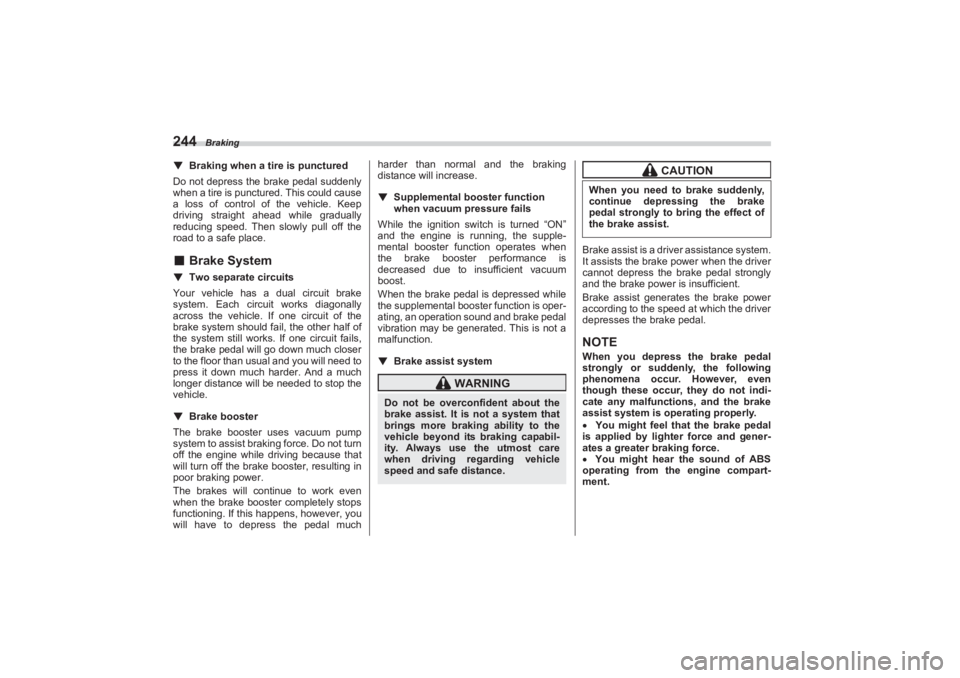
Braking
244▼Braking when a tire is punctured
Do not depress the brake pedal suddenly
when a tire is punctured. This could cause
a loss of control of the vehicle. Keep
driving straight ahead while gradually
reducing speed. Then slowly pull off the
road to a safe place.■ Brake System▼ Two separate circuits
Your vehicle has a dual circuit brake
system. Each circuit works diagonally
across the vehicle. If one circuit of the
brake system should fail, the other half of
the system still works. If one circuit fails,
the brake pedal will go down much closer
to the floor than usual and you will need to
press it down much harder. And a much
longer distance will be needed to stop the
vehicle.
▼ Brake booster
The brake booster uses vacuum pump
system to assist brakin g force. Do not turn
off the engine while driving because that
will turn off the brake booster, resulting in
poor braking power.
The brakes will continue to work even
when the brake booster completely stops
functioning. If this happens, however, you
will have to depress the pedal much harder than normal and the braking
distance will increase.
▼ Supplemental booster function
when vacuum pressure fails
While the ignition switch is turned “ON”
and the engine is running, the supple-
mental booster function operates when
the brake booster performance is
decreased due to insufficient vacuum
boost.
When the brake pedal is depressed while
the supplemental booster function is oper-
ating, an operation sound and brake pedal
vibration may be generated. This is not a
malfunction.
▼ Brake assist system
Brake assist is a driver assistance system.
It assists the brake power when the driver
cannot depress the brake pedal strongly
and the brake power is insufficient.
Brake assist generates the brake power
according to the speed at which the driver
depresses the brake pedal.NOTEWhen you depress the brake pedal
strongly or suddenly, the following
phenomena occur. However, even
though these occur, they do not indi-
cate any malfunctions, and the brake
assist system is operating properly.
You might feel that the brake pedal
is applied by lighter force and gener-
ates a greater braking force.
You might hear the sound of ABS
operating from the engine compart-
ment.
WARNING
Do not be overconfident about the
brake assist. It is not a system that
brings more braking ability to the
vehicle beyond its braking capabil-
ity. Always use the utmost care
when driving regarding vehicle
speed and safe distance.
CAUTION
When you need to brake suddenly,
continue depressing the brake
pedal strongly to bring the effect of
the brake assist.
BRZ_U.book 244 ページ 2022年3月29日 火曜日 午後3時59分
Page 251 of 432
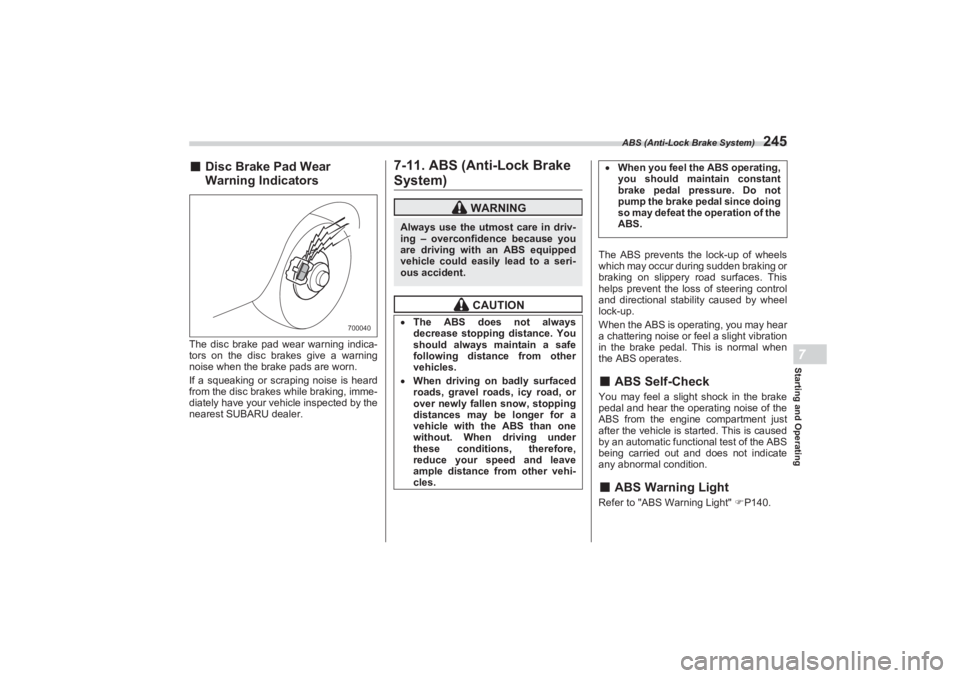
ABS (Anti-Lock Brake System)
245
Starting and Operating7
■Disc Brake Pad Wear
Wa rning IndicatorsThe disc brake pad wear warning indica-
tors on the disc brakes give a warning
noise when the brake pads are worn.
If a squeaking or scraping noise is heard
from the disc brakes while braking, imme-
diately have your vehicle inspected by the
nearest SUBARU dealer.
7-11. ABS (Anti-Lock BrakeSystem)
The ABS prevents the lock-up of wheels
which may occur during sudden braking or
braking on slippery road surfaces. This
helps prevent the loss of steering control
and directional stability caused by wheel
lock-up.
When the ABS is operating, you may hear
a chattering noise or f eel a slight vibration
in the brake pedal. This is normal when
the ABS operates.■ ABS Self-CheckYou may feel a slight shock in the brake
pedal and hear the operating noise of the
ABS from the engine compartment just
after the vehicle is started. This is caused
by an automatic functional test of the ABS
being carried out and does not indicate
any abnormal condition.■ ABS Warning LightRefer to "ABS Warning Light" P140.
700040
WARNING
Always use the utmost care in driv-
ing – overconfidence because you
are driving with an ABS equipped
vehicle could easily lead to a seri-
ous accident.
CAUTION
The ABS does not always
decrease stopping distance. You
should always maintain a safe
following distance from other
vehicles. When driving on badly surfaced
roads, gravel roads, icy road, or
over newly fallen snow, stopping
distances may be longer for a
vehicle with the ABS than one
without. When driving under
these conditions, therefore,
reduce your speed and leave
ample distance from other vehi-
cles.
When you feel the ABS operating,
you should maintain constant
brake pedal pressure. Do not
pump the brake pedal since doing
so may defeat the operation of the
ABS.
BRZ_U.book 245 ページ 2022年3月29日 火曜日 午後3時59分
Page 252 of 432
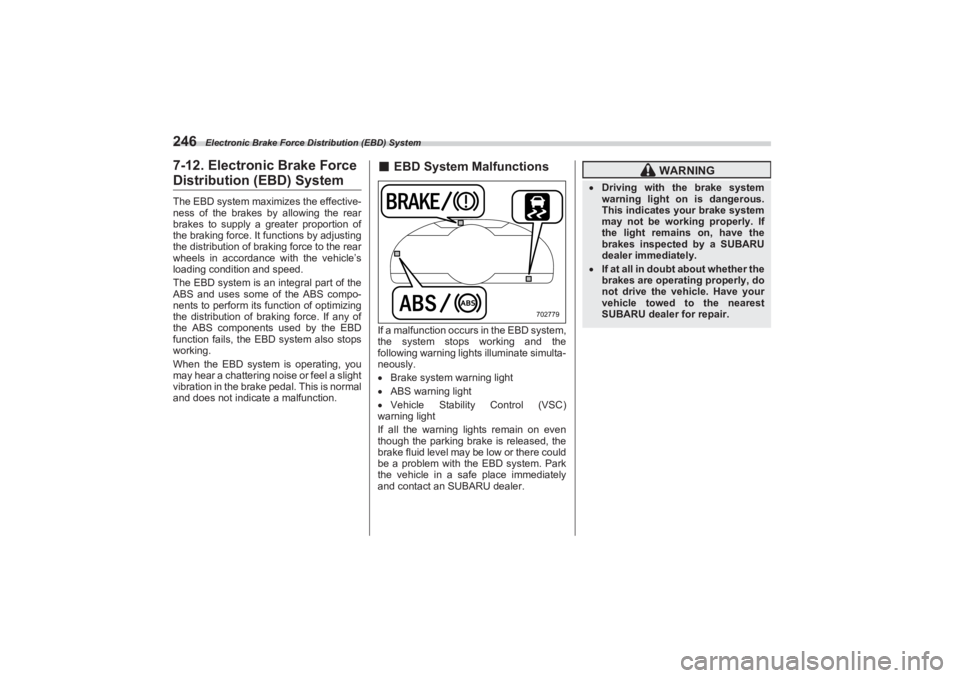
Electronic Brake Force Distribution (EBD) System
2467-12. Electronic Brake Force Distribution (EBD) SystemThe EBD system maximizes the effective-
ness of the brakes by allowing the rear
brakes to supply a greater proportion of
the braking force. It functions by adjusting
the distribution of braking force to the rear
wheels in accordance with the vehicle’s
loading condition and speed.
The EBD system is an in tegral part of the
ABS and uses some of the ABS compo-
nents to perform its function of optimizing
the distribution of braking force. If any of
the ABS components used by the EBD
function fails, the EBD system also stops
working.
When the EBD system is operating, you
may hear a chattering noise or feel a slight
vibration in the brake pedal. This is normal
and does not indicate a malfunction.
■ EBD System MalfunctionsIf a malfunction occurs in the EBD system,
the system stops working and the
following warning lights illuminate simulta-
neously.
Brake system warning light
ABS warning light
Vehicle Stability Control (VSC)
warning light
If all the warning lights remain on even
though the parking brake is released, the
brake fluid level may be low or there could
be a problem with the EBD system. Park
the vehicle in a safe place immediately
and contact an SUBARU dealer.
702779
WARNING
Driving with the brake system
warning light on is dangerous.
This indicates your brake system
may not be working properly. If
the light remains on, have the
brakes inspected by a SUBARU
dealer immediately. If at all in doubt about whether the
brakes are operating properly, do
not drive the vehicle. Have your
vehicle towed to the nearest
SUBARU dealer for repair.
BRZ_U.book 246 ページ 2022年3月29日 火曜日 午後3時59分
Page 283 of 432
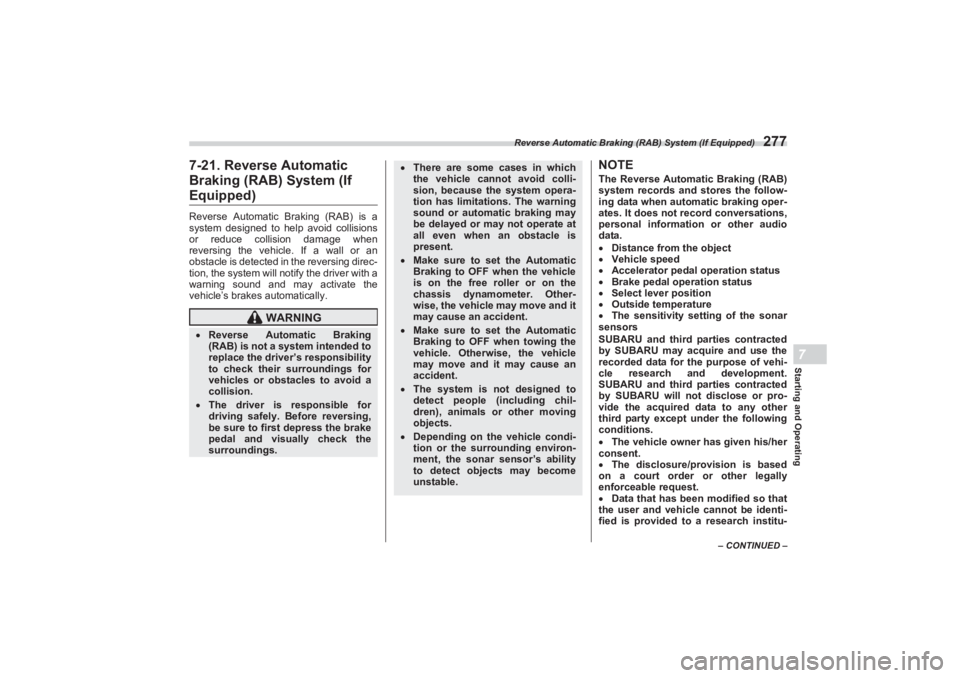
Reverse Automatic Braking (RAB) System (If Equipped)
277
Starting and Operating7
– CONTINUED –
7-21. Reverse Automatic
Braking (RAB) System (If Equipped)Reverse Automatic Braking (RAB) is a
system designed to help avoid collisions
or reduce collision damage when
reversing the vehicle. If a wall or an
obstacle is detected in the reversing direc-
tion, the system will notify the driver with a
warning sound and may activate the
vehicle’s brakes automatically.
NOTEThe Reverse Automatic Braking (RAB)
system records and stores the follow-
ing data when automatic braking oper-
ates. It does not record conversations,
personal information or other audio
data.
Distance from the object
Vehicle speed
Accelerator pedal operation status
Brake pedal operation status
Select lever position
Outside temperature
The sensitivity setting of the sonar
sensors
SUBARU and third parties contracted
by SUBARU may acquire and use the
recorded data for the purpose of vehi-
cle research and development.
SUBARU and third parties contracted
by SUBARU will not disclose or pro-
vide the acquired data to any other
third party except under the following
conditions.
The vehicle owner has given his/her
consent.
The disclosure/provision is based
on a court order or other legally
enforceable request.
Data that has been modified so that
the user and vehicle cannot be identi-
fied is provided to a research institu-
WARNING
Reverse Automatic Braking
(RAB) is not a system intended to
replace the driver’s responsibility
to check their surroundings for
vehicles or obstacles to avoid a
collision. The driver is responsible for
driving safely. Before reversing,
be sure to first depress the brake
pedal and visually check the
surroundings.
There are some cases in which
the vehicle cannot avoid colli-
sion, because the system opera-
tion has limitations. The warning
sound or automatic braking may
be delayed or may not operate at
all even when an obstacle is
present. Make sure to set the Automatic
Braking to OFF when the vehicle
is on the free roller or on the
chassis dynamometer. Other-
wise, the vehicle may move and it
may cause an accident. Make sure to set the Automatic
Braking to OFF when towing the
vehicle. Otherwis e, the vehicle
may move and it may cause an
accident. The system is not designed to
detect people (including chil-
dren), animals or other moving
objects. Depending on the vehicle condi-
tion or the surrounding environ-
ment, the sonar sensor’s ability
to detect objects may become
unstable.
BRZ_U.book 277 ページ 2022年3月29日 火曜日 午後3時59分
Page 300 of 432
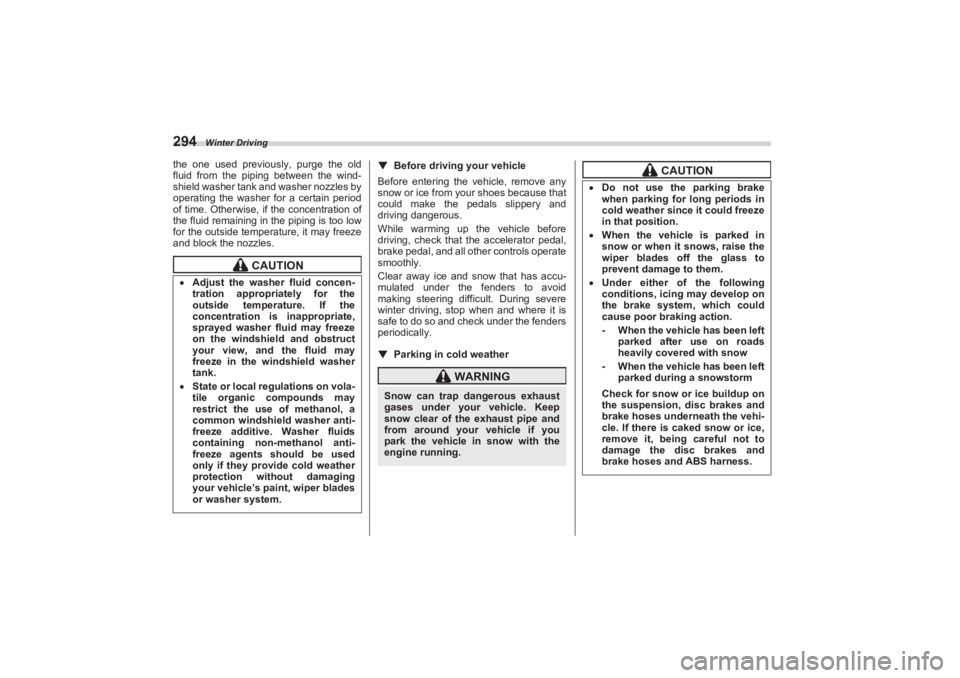
Winter Driving
294the one used previously, purge the old
fluid from the piping between the wind-
shield washer tank and washer nozzles by
operating the washer for a certain period
of time. Otherwise, if the concentration of
the fluid remaining in the piping is too low
for the outside temperature, it may freeze
and block the nozzles.
▼ Before driving your vehicle
Before entering the vehicle, remove any
snow or ice from your shoes because that
could make the pedals slippery and
driving dangerous.
While warming up the vehicle before
driving, check that the accelerator pedal,
brake pedal, and all other controls operate
smoothly.
Clear away ice and snow that has accu-
mulated under the fenders to avoid
making steering difficult. During severe
winter driving, stop when and where it is
safe to do so and check under the fenders
periodically.
▼ Parking in cold weather
CAUTION
Adjust the washer fluid concen-
tration appropriately for the
outside temperature. If the
concentration is inappropriate,
sprayed washer fluid may freeze
on the windshield and obstruct
your view, and the fluid may
freeze in the windshield washer
tank. State or local regulations on vola-
tile organic compounds may
restrict the use of methanol, a
common windshield washer anti-
freeze additive. Washer fluids
containing non-methanol anti-
freeze agents should be used
only if they provide cold weather
protection without damaging
your vehicle’s paint, wiper blades
or washer system.
WARNING
Snow can trap dangerous exhaust
gases under your vehicle. Keep
snow clear of the exhaust pipe and
from around your vehicle if you
park the vehicle in snow with the
engine running.
CAUTION
Do not use the parking brake
when parking for long periods in
cold weather since it could freeze
in that position. When the vehicle is parked in
snow or when it snows, raise the
wiper blades off the glass to
prevent damage to them. Under either of the following
conditions, icing may develop on
the brake system, which could
cause poor braking action.
- When the vehicle has been left
parked after use on roads
heavily covered with snow- When the vehicle has been left
parked during a snowstormCheck for snow or ice buildup on
the suspension, disc brakes and
brake hoses underneath the vehi-
cle. If there is caked snow or ice,
remove it, being careful not to
damage the disc brakes and
brake hoses and ABS harness.
BRZ_U.book 294 ページ 2022年3月29日 火曜日 午後3時59分
Page 338 of 432
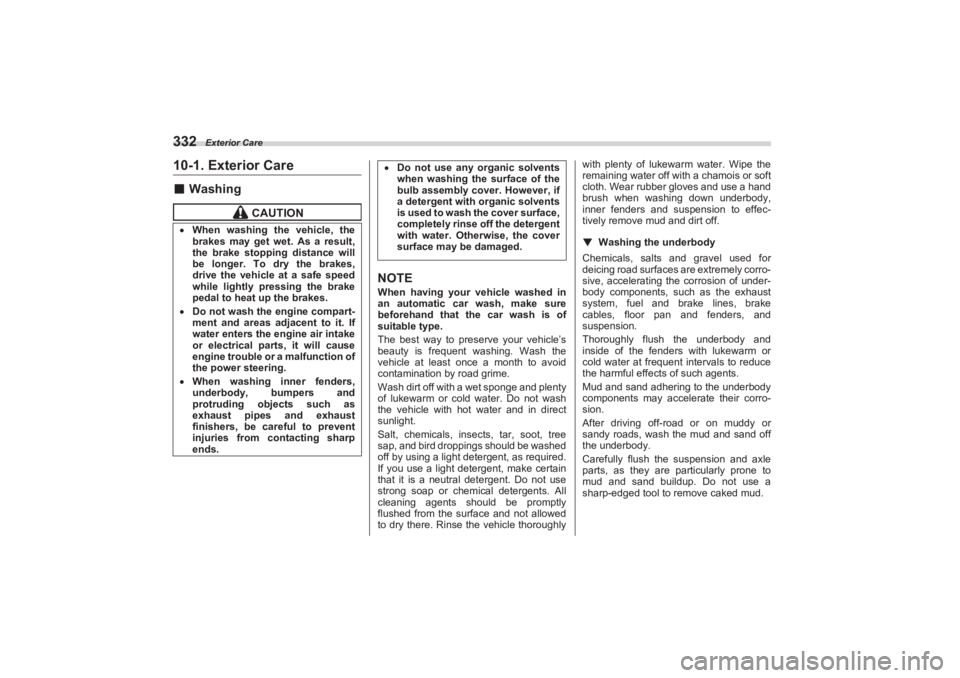
Exterior Care
33210-1. Exterior Care■Washing
NOTE
When having your vehicle washed in
an automatic car wash, make sure
beforehand that the car wash is of
suitable type.
The best way to preserve your vehicle’s
beauty is frequent washing. Wash the
vehicle at least once a month to avoid
contamination by road grime.
Wash dirt off with a wet sponge and plenty
of lukewarm or cold water. Do not wash
the vehicle with hot water and in direct
sunlight.
Salt, chemicals, insects, tar, soot, tree
sap, and bird droppings should be washed
off by using a light detergent, as required.
If you use a light detergent, make certain
that it is a neutral detergent. Do not use
strong soap or chemical detergents. All
cleaning agents should be promptly
flushed from the surface and not allowed
to dry there. Rinse the vehicle thoroughly with plenty of lukewarm water. Wipe the
remaining water off with a chamois or soft
cloth. Wear rubber gloves and use a hand
brush when washing down underbody,
inner fenders and suspension to effec-
tively remove mud and dirt off.
▼ Washing the underbody
Chemicals, salts and gravel used for
deicing road surfaces are extremely corro-
sive, accelerating the corrosion of under-
body components, such as the exhaust
system, fuel and brake lines, brake
cables, floor pan and fenders, and
suspension.
Thoroughly flush the underbody and
inside of the fenders with lukewarm or
cold water at frequent intervals to reduce
the harmful effects of such agents.
Mud and sand adhering to the underbody
components may accelerate their corro-
sion.
After driving off-road or on muddy or
sandy roads, wash the mud and sand off
the underbody.
Carefully flush the suspension and axle
parts, as they are particularly prone to
mud and sand buildup. Do not use a
sharp-edged tool to remove caked mud.
CAUTION
When washing the vehicle, the
brakes may get wet. As a result,
the brake stopping distance will
be longer. To dry the brakes,
drive the vehicle at a safe speed
while lightly pressing the brake
pedal to heat up the brakes. Do not wash the engine compart-
ment and areas adjacent to it. If
water enters the engine air intake
or electrical parts, it will cause
engine trouble or a malfunction of
the power steering. When washing inner fenders,
underbody, bumpers and
protruding objects such as
exhaust pipes and exhaust
finishers, be careful to prevent
injuries from contacting sharp
ends.
Do not use any organic solvents
when washing the surface of the
bulb assembly cover. However, if
a detergent with organic solvents
is used to wash the cover surface,
completely rinse off the detergent
with water. Otherwise, the cover
surface may be damaged.
BRZ_U.book 332 ページ 2022年3月29日 火曜日 午後3時59分
Page 363 of 432
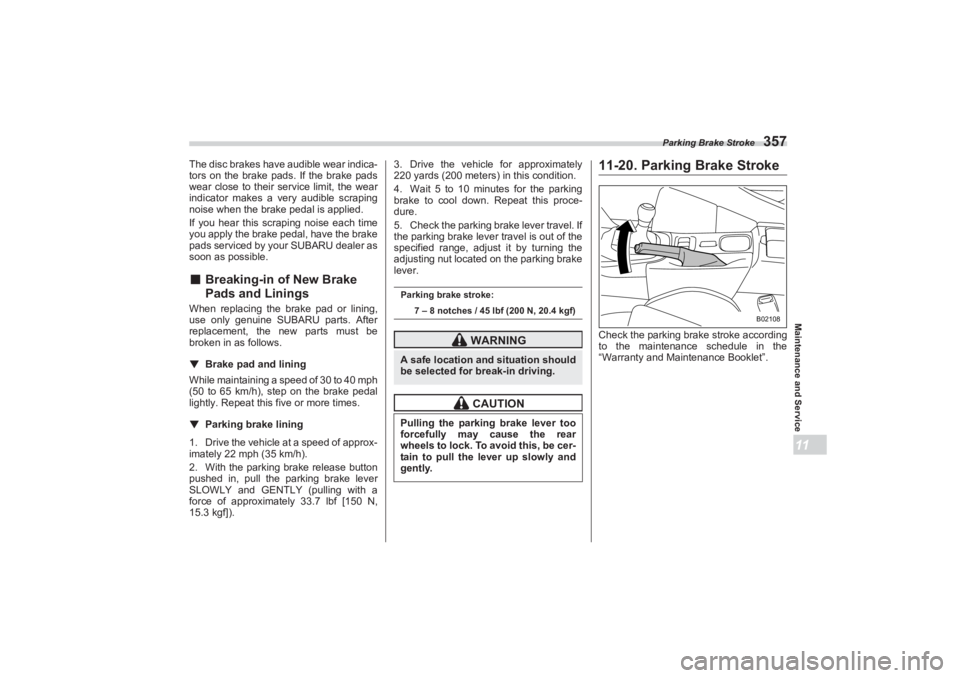
Parking Brake Stroke
357
Maintenance and Service11
The disc brakes have audible wear indica-
tors on the brake pads. If the brake pads
wear close to their service limit, the wear
indicator makes a very audible scraping
noise when the brake pedal is applied.
If you hear this scraping noise each time
you apply the brake pedal, have the brake
pads serviced by your SUBARU dealer as
soon as possible.■ Breaking-in of New Brake
Pad s and LiningsWhen replacing the brake pad or lining,
use only genuine SUBARU parts. After
replacement, the new parts must be
broken in as follows.
▼ Brake pad and lining
While maintaining a speed of 30 to 40 mph
(5 0 to 65 km/h), step on the brake pedal
lightly. Repeat this five or more times.
▼ Parking brake lining1. Drive the vehicle at a speed of approx-
imately 22 mph (35 km/h).
2. With the parking brake release button
pushed in, pull the parking brake lever
SLOWLY and GENTLY (pulling with a
force of approximately 33.7 lbf [150 N,
15.3 kgf]). 3. Drive the vehicle for approximately
220 yards (200 meters) in this condition.
4. Wait 5 to 10 minutes for the parking
brake to cool down. Repeat this proce-
dure.
5. Check the parking brake lever travel. If
the parking brake lever travel is out of the
specified range, adjust it by turning the
adjusting nut located on the parking brake
lever.
11-20. Parking Brake StrokeCheck the parking brak e stroke according
to the maintenance schedule in the
“Warranty and Maintenance Booklet”.
Parking brake stroke:
7 – 8 notches / 45 lbf (200 N, 20.4 kgf)
WARNING
A safe location and situation should
be selected for break-in driving.
CAUTION
Pulling the parking brake lever too
forcefully may cause the rear
wheels to lock. To avoid this, be cer-
tain to pull the lever up slowly and
gently.
B02108
BRZ_U.book 357 ページ 2022年3月29日 火曜日 午後3時59分